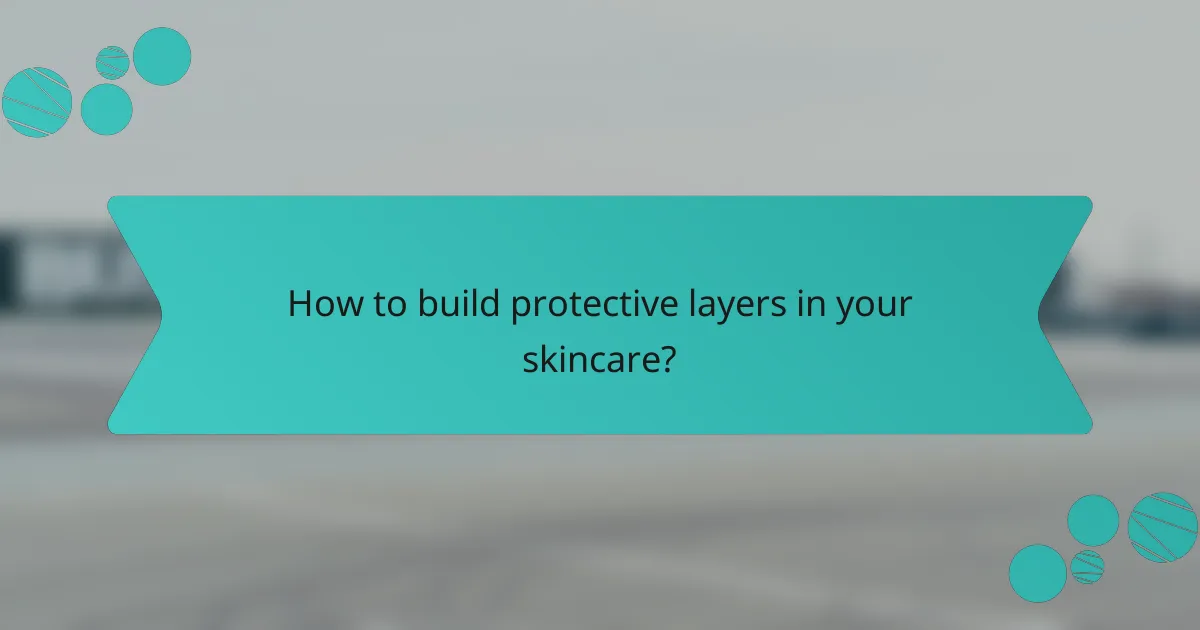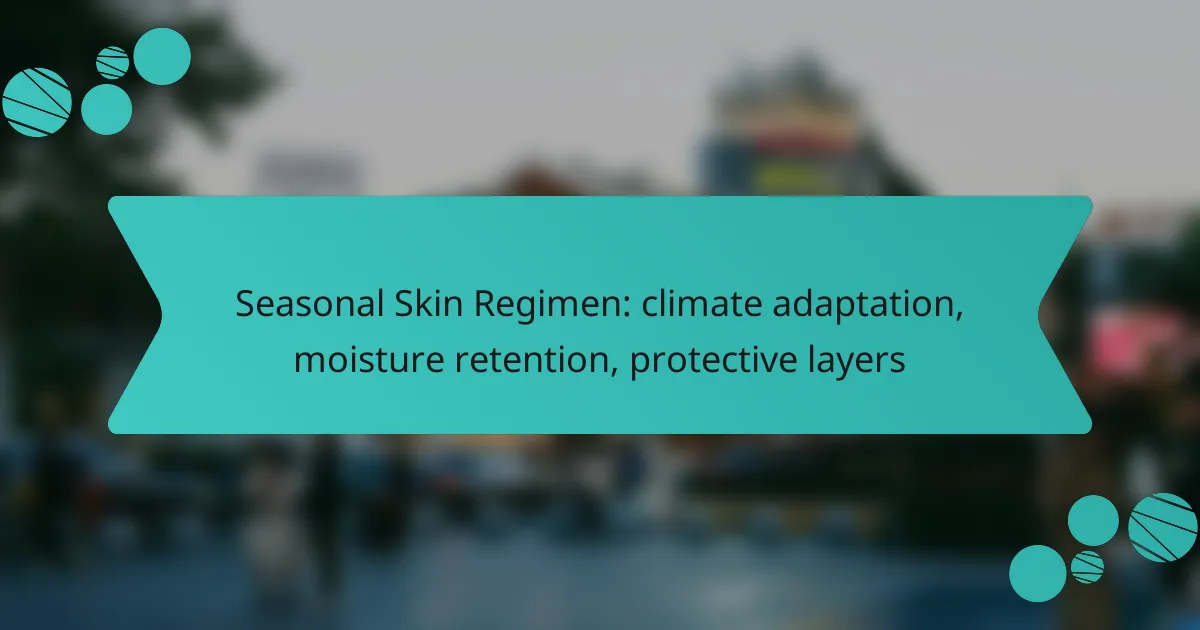Adapting your skin regimen to the UK’s variable climate is crucial for maintaining healthy skin. Focus on hydration and protection to combat moisture loss from the damp and chilly environment. Incorporating products with humectants, occlusives, and emollients will help lock in moisture, while layering your skincare effectively can shield your skin from environmental stressors.

How to adapt your skin regimen for UK climates?
Adapting your skin regimen for UK climates involves focusing on hydration, protection, and nourishment due to the variable weather conditions. The UK’s often damp and chilly environment can lead to moisture loss, so it’s essential to use products that retain hydration and protect the skin barrier.
Moisturizing with hyaluronic acid
Hyaluronic acid is a powerful humectant that draws moisture into the skin, making it ideal for the UK’s often dry indoor heating. Look for serums or creams containing this ingredient, applying them after cleansing to lock in hydration.
For best results, choose products with a concentration of 1-2% hyaluronic acid. Layering it under a heavier moisturizer can enhance its effectiveness, especially during colder months when skin tends to lose moisture more rapidly.
Using SPF protection daily
Daily SPF protection is crucial, even in the UK, where cloudy days can still expose skin to harmful UV rays. Opt for a broad-spectrum sunscreen with at least SPF 30 to shield against both UVA and UVB rays.
Apply sunscreen every morning, regardless of the weather, and reapply every two hours if outdoors. Consider a moisturizer with built-in SPF for convenience, ensuring you maintain protection without adding extra steps to your routine.
Incorporating antioxidants
Antioxidants help combat environmental stressors and free radicals, which can be prevalent in urban UK settings. Ingredients like vitamin C and E can boost your skin’s resilience and promote a brighter complexion.
Incorporate a vitamin C serum in the morning before applying sunscreen, as it can enhance sun protection and improve skin tone. Look for products with a concentration of 10-20% vitamin C for optimal benefits, and consider using vitamin E in your nighttime routine for added nourishment.

What are the best products for moisture retention?
The best products for moisture retention typically contain ingredients that help to hydrate the skin and lock in moisture. Look for creams and lotions with humectants, occlusives, and emollients to effectively maintain skin hydration throughout the day.
CeraVe Moisturizing Cream
CeraVe Moisturizing Cream is a popular choice for moisture retention due to its unique formulation that includes essential ceramides and hyaluronic acid. These ingredients work together to restore the skin’s natural barrier and retain moisture effectively.
This cream is suitable for various skin types, including dry and sensitive skin. Its non-comedogenic formula ensures that it won’t clog pores, making it a versatile option for daily use.
The Ordinary Natural Moisturizing Factors
The Ordinary Natural Moisturizing Factors is designed to mimic the skin’s natural moisturizing components, providing immediate hydration. It contains a blend of amino acids, fatty acids, and other compounds that help to maintain skin moisture levels.
This product is lightweight and absorbs quickly, making it ideal for layering under other skincare products. It is particularly beneficial for those looking for a simple yet effective solution for moisture retention without heavy oils or creams.

How to build protective layers in your skincare?
Building protective layers in your skincare involves applying products in a specific order to enhance moisture retention and shield your skin from environmental stressors. The key is to start with lighter formulations and gradually layer heavier products to create an effective barrier.
Layering serums and oils
When layering serums and oils, begin with a hydrating serum that contains ingredients like hyaluronic acid or glycerin. These lightweight formulations penetrate the skin quickly, delivering moisture effectively.
After the serum, apply a nourishing oil to seal in hydration. Look for oils rich in fatty acids, such as jojoba or argan oil, which help maintain moisture without clogging pores. A good rule of thumb is to use one to two drops of oil, adjusting based on your skin type.
Choosing the right sunscreen
Selecting the right sunscreen is crucial for protecting your skin from UV damage. Look for broad-spectrum sunscreens with an SPF of at least 30, which provides adequate protection against both UVA and UVB rays.
Consider your skin type when choosing a sunscreen. For oily skin, opt for a gel-based or matte finish formula, while dry skin may benefit from cream-based sunscreens. Remember to apply sunscreen generously and reapply every two hours, especially if you’re outdoors or sweating.

What are the seasonal skin challenges in the UK?
The UK experiences distinct seasonal skin challenges primarily due to its variable climate. In winter, cold temperatures and low humidity can lead to dehydration, while summer brings increased UV exposure, risking sun damage.
Dehydration in winter
During winter in the UK, skin often suffers from dehydration due to cold air and indoor heating, which strip moisture from the skin. This can result in dryness, flakiness, and irritation.
To combat winter dehydration, it’s crucial to use a rich moisturizer that contains ingredients like hyaluronic acid or glycerin, which help retain moisture. Additionally, consider using a humidifier indoors to maintain humidity levels.
Sun damage in summer
In summer, the UK sees increased sun exposure, which can lead to skin damage, including sunburn and premature aging. Even on cloudy days, UV rays can penetrate the skin and cause harm.
To protect against sun damage, apply a broad-spectrum sunscreen with an SPF of at least 30 every two hours when outdoors. Wearing protective clothing and seeking shade during peak sun hours can further reduce the risk of skin damage.

How do environmental factors affect skin health?
Environmental factors significantly influence skin health by impacting its barrier function, hydration levels, and overall resilience. Elements such as pollution, humidity, and temperature can either compromise or enhance skin’s natural defenses, requiring tailored care strategies.
Pollution and skin barrier function
Pollution can weaken the skin’s barrier, leading to increased sensitivity and irritation. Particulate matter and harmful chemicals can penetrate the skin, causing oxidative stress and inflammation. Regular cleansing and the use of antioxidants can help mitigate these effects.
To protect against pollution, consider incorporating products with ingredients like vitamin C, niacinamide, or green tea extract. These can help neutralize free radicals and strengthen the skin barrier. Additionally, using a physical sunscreen can provide an extra layer of defense against environmental aggressors.
Humidity levels and skin hydration
Humidity levels play a crucial role in skin hydration. In high humidity, skin tends to retain moisture better, while low humidity can lead to dryness and flakiness. It’s essential to adjust your skincare routine based on seasonal changes in humidity to maintain optimal hydration.
During dry months, opt for heavier creams or occlusives that lock in moisture, while in humid conditions, lighter formulations such as gels or serums may be more suitable. Regularly using a humidifier indoors can also help counteract dry air, especially in winter months.

What are the signs of seasonal skin issues?
Seasonal skin issues often manifest as noticeable changes in texture and sensitivity due to environmental shifts. Common signs include dry patches, flakiness, increased sensitivity, and redness, which can vary in severity depending on the climate and individual skin type.
Dry patches and flakiness
Dry patches and flakiness occur when the skin loses moisture, often exacerbated by cold or dry weather. This condition can lead to rough, scaly areas that may feel tight or uncomfortable.
To combat dry patches, consider using a thicker moisturizer or an occlusive product that locks in hydration. Look for ingredients like hyaluronic acid, glycerin, or ceramides, which help retain moisture effectively.
Avoid hot showers and harsh soaps, as these can strip natural oils from the skin. Instead, opt for lukewarm water and gentle, hydrating cleansers to maintain your skin’s moisture barrier.
Increased sensitivity and redness
Increased sensitivity and redness can arise from abrupt temperature changes or exposure to irritants, leading to a reactive skin response. This may manifest as stinging, burning, or visible redness, particularly for those with sensitive skin types.
To soothe sensitive skin, use fragrance-free and hypoallergenic products. Incorporating calming ingredients like aloe vera or chamomile can help reduce inflammation and irritation.
It’s advisable to patch-test new products and avoid excessive exfoliation during seasons when your skin is more reactive. This cautious approach can prevent further irritation and promote a healthier skin barrier.

How to choose skincare based on skin type?
Selecting skincare products based on your skin type is essential for achieving optimal results. Different skin types—such as oily, dry, combination, and sensitive—require tailored approaches to maintain balance and health.
Climate adaptation
Your skincare routine should adapt to the climate you live in, as environmental factors can significantly impact your skin’s needs. For instance, in humid climates, lighter, oil-free moisturizers may be more effective, while in dry, cold areas, richer creams and oils can help retain moisture.
Consider using products with ingredients that provide hydration and protection against environmental stressors. Look for humectants like hyaluronic acid in humid conditions and occlusives like shea butter in dry climates to help lock in moisture.
Moisture retention
Moisture retention is crucial for maintaining healthy skin, regardless of your skin type. Incorporating products that enhance hydration, such as serums and creams with glycerin or aloe vera, can help keep your skin plump and supple.
To maximize moisture retention, apply products while your skin is still slightly damp. This technique helps to seal in hydration and can be particularly effective after cleansing or during a shower.
Protective layers
Creating protective layers on your skin can shield it from environmental aggressors and prevent moisture loss. Start with a lightweight serum, followed by a moisturizer, and finish with a sunscreen during the day to protect against UV damage.
For nighttime routines, consider using a thicker cream or an overnight mask to provide an additional barrier while you sleep. This layered approach can help maintain skin health and improve overall texture and appearance.
